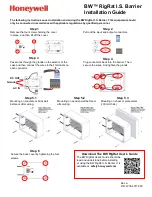
401665 V1.01 9/98
Owner’s Manual
Model 401665
Non-Contact Voltage/Metal Detector
Congratulations on your purchase of Extech's Non-contact Metal/Voltage
Detector which locates metal studs, conduit, nails/screws, and pipes
through walls. The Detector will also check fuses, lamps, and bulbs,
verify component/battery polarity, determine HOT/LIVE/NEUTRAL wiring
configurations, check AC power, DC voltages, diodes, continuity, LEDs,
and appliance grounds. Microwave oven leakage radiation can also be
determined as well as safe viewing distances from TV, PC, or Video
terminals.
Controls
(see diagram above)
1. Metal Detector (adjusts 90
o
)
6. Continuity test plate
2. Battery compartment
7. LED status indicator
3. Pocket Clip
8. Select switch
4. AC voltage and microwave sensor 9. Sensitivity adjust knob
5. Continuity test pin
Specifications:
Continuity
0 to 50 ohms
DC Voltage/Polarity
2 to 36VDC
AC Voltage (non-contact) 70 to 600VAC
Microwave leakage
> 5mW/sq.cm
Metal Detection
a. Set the function switch (figure 1) to the "
I
" position.
b. To find the maximum sensitivity, turn the sensitivity knob (figure 1)
forward - where the knob's gradations are larger - until the LED and
audible tone turn off.
c. Position the metal sensor arm (fig. 1) at a convenient angle for use.
The sensor extends 90o.
d. Point the metal sensor arm toward the area where metal is to be
detected. Move the sensor arm slowly and smoothly across a surface
area, approaching from different directions.
e. An audible tone and the LED will alert the user as to the presence of
metal.
f. To narrow the sensitivity, turn the sensitivity knob backwards (to where
the knob gradations are smaller).
Hints about Metal Detection
1. It is not suitable to detect metal in walls or ceilings insulated with
metallic foil.
2. The depth to which metal can be detected is dependent upon the
object's size. The greater the object size, the greater the depth of
metal detection.
AC Voltage Detection
a. Set the function switch (figure 1) to the "
II
" position.
b. To find the maximum sensitivity, turn the sensitivity knob (figure 1)
forward - where the knob's gradations are larger - until the LED and
audible tone turn off.
c. Point the meter toward the area where an AC signal is to be detected.
Move the meter near the surface under test (switch, socket, plug, wire,
conduit, etc.).
e. An audible tone and the LED will alert the user as to the presence of
an AC signal.
f. To narrow the sensitivity, turn the sensitivity knob backwards (to where
the knob gradations are smaller).
AC Measurement Notes
1. Static electricity may cause false indications. Avoid meter contact with
static generating materials such as rugs, sweaters, etc.
2. The meter's sensitivity may be reduced in high humidity areas.
3. The sensitivity increases when the continuity test plate (figure 1) is
touched.
AC Wire "Break Point" Detection
a. Setup and position the meter to detect AC voltage as in the above
section "AC Voltage Detection".
b. Turn the sensitivity knob to where the knob's gradations are larger
(Max sensitivity).
c. Move the meter along the wire until the break point is located.
c. The break point is found when the audible and LED alert ceases,
indicating that AC voltage is no longer present.
Earth Ground Detection on Appliances and other Devices
a. Setup and position the meter to detect AC voltage as in the above
section "AC Voltage Detection".
b. Move the meter along the surface of the device under test with the
device's power off.
c. The audible and LED alerts will appear if the appliance or other device
is not connected to earth ground.
Verifying AC power connection in Appliances
a. Setup and position the meter to detect AC voltage as in the above
section "AC Voltage Detection".
b. Move the meter close the device under test.
c. The audible and LED alerts will appear if the power plug is inserted
incorrectly into a wall socket.
Determine suggested viewing distance from TV, Computer
Monitors, and Video Terminals
a. Setup and position the meter to detect AC voltage as in the above
section "AC Voltage Detection".
b. The suggested distance is determined by moving the meter from a
close distance to a further distance away from a TV (with TV power
ON) and listening for the audible alert tone to extinguish (the LED also
provides status indication).
c. At close proximity to the TV or other device, the meter will sound a
tone. As the meter moves away from the device it will eventually
cease the alert signal. This will be at a suggested viewing distance.
Continuity / Low Resistance Checks
Caution:
Remove power to devices before checking continuity.
Any voltage present will be present at the continuity test plate!
Serious injury or death can result.
Always discharge components before performing continuity tests.
Devices such as lamps, bulbs, fuses, heating elements, coils,
transformers, inductors, etc. can be tested for continuity. The following
steps provide general instructions for testing continuity. Thereafter,
special instructions are provided for capacitors, diodes, transistors, home
appliances, etc.




















